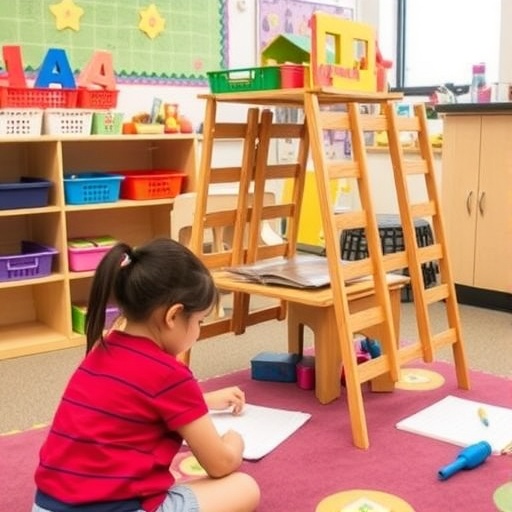In a groundbreaking exploration of early childhood education, a recent study highlights the effectiveness of guided play in kindergarten classrooms, particularly as a scaffold for play-based writing instruction. The research, conducted by Angela Sanchez, showcases how one educator’s inquiry into her teaching practices led to innovative strategies that enhance children’s engagement and learning outcomes. This pivotal study examines the intersection of play and literacy, revealing the significant implications for educational methods in the formative years of a child’s development.
At the core of Sanchez’s investigation is the notion that play is not merely a leisure activity for young children but also a critical context for learning. When structured effectively, guided play can foster a rich environment where children express their creativity, practice language skills, and develop concepts related to writing. The study emphasizes how educators can strategically scaffold children’s learning during play, providing necessary support while still allowing for freedom and exploration.
Sanchez’s approach involves creating a thoughtful balance between teacher-directed activities and child-led play. By incorporating elements of guided play, she seeks to cultivate a classroom atmosphere that nurtures curiosity while promoting essential literacy skills. The findings indicate that when teachers intervene at moments of potential learning, they can introduce vocabulary, concepts, and writing techniques in a manner that resonates with students’ interests and experiences.
Furthermore, the research underscores the importance of intentional planning by educators. Sanchez advocates for the careful design of play environments and scenarios that specifically target writing development. By embedding literacy activities into familiar play contexts, children are more likely to engage meaningfully with the task at hand. The study reveals that such integration not only supports writing skills but also enhances overall communication abilities, laying a robust foundation for future learning.
Throughout the study, Sanchez draws on a wealth of observational data, noting the varied responses of children during guided play sessions. Many students exhibited increased motivation and enthusiasm for writing, particularly when the activities were linked to their own interests. The research highlights how play-based instruction provides a unique opportunity for children to practice writing in a low-pressure setting, fostering a love for literacy that extends beyond the classroom.
In addition to individual growth, the interactions during guided play foster collaborative skills among peers. Sanchez notes that as children engage in joint play activities, they enhance their ability to communicate effectively with one another. This collaborative dynamic serves to enrich children’s learning experiences, allowing them to negotiate, share ideas, and collectively problem-solve. Such social interactions underscore the value of play as a vehicle for both cognitive and social development.
While the findings present a compelling case for guided play, Sanchez does not shy away from discussing the challenges that educators may face in implementing these approaches. She acknowledges that balancing curriculum demands with the spontaneity of play can be difficult, particularly in traditional educational settings that prioritize standardized assessment outcomes. Educators must navigate these pressures while advocating for play as a legitimate and valuable mode of learning.
Sanchez’s study also highlights the role of professional development in equipping teachers to effectively facilitate guided play. The research suggests that ongoing training and resources for educators are crucial in empowering them to integrate play-based instruction into their classrooms confidently. By fostering a community of practice among teachers, schools can cultivate an environment where innovative teaching methods thrive, ultimately benefiting students.
In conclusion, the insights gleaned from Sanchez’s study have far-reaching implications for early childhood education. By embracing guided play as a pedagogical strategy, educators can unlock children’s potential, making literacy instruction more engaging and effective. As the landscape of education continues to evolve, the integration of play and academics stands out as a progressive approach that aligns with children’s developmental needs. The study serves as an important reminder that learning can and should be a joyous adventure, driven by curiosity and exploration.
Through Sanchez’s inquiry into scaffolding play-based writing instruction, we are reminded of the profound impact that thoughtful, child-centered teaching can have on young learners. As education continues to adapt to the needs of future generations, the principles of guided play offer a promising path forward, harmonizing the joys of childhood with the essential skills needed for academic success.
Subject of Research: Guided play as a tool for scaffolding play-based writing instruction in kindergarten classrooms.
Article Title: Guided Play in the Kindergarten Classroom: One Teacher’s Inquiry into Scaffolding Play-Based Writing Instruction.
Article References:
Sanchez, A. Guided Play in the Kindergarten Classroom: One Teacher’s Inquiry into Scaffolding Play-Based Writing Instruction.
Early Childhood Educ J 53, 2089–2098 (2025). https://doi.org/10.1007/s10643-025-01931-w
Image Credits: AI Generated
DOI: 10.1007/s10643-025-01931-w
Keywords: guided play, play-based learning, early childhood education, literacy instruction, teacher inquiry, social development.




